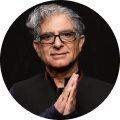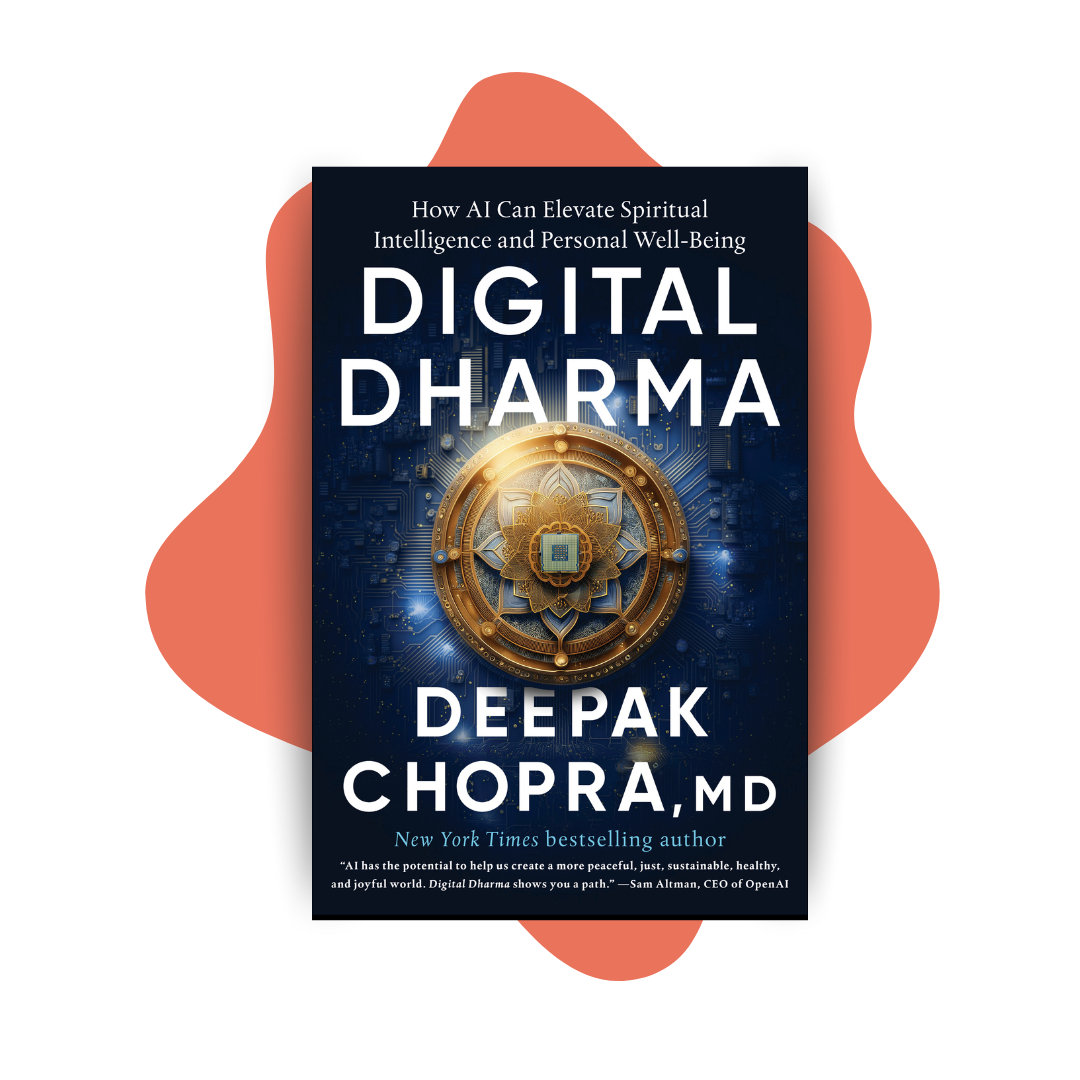Home › Podcasts › Science and Spirituality with Deepak Chopra › Quantum Body With Special Guests John Horgan, Jack Tuszynski, And Brian Fertig
Quantum Body With Special Guests John Horgan, Jack Tuszynski, And Brian Fertig.
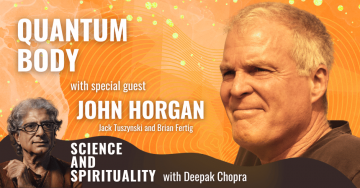
Our physical body is deemed to age, get injured, decay, and rot, but the quantum body exists, and it’s infinite. The quantum body is the source of our daily reality, and the physical body will cease to exist without it. Today, Deepak Chopra, John Horgan, Jack Tuszynski, and Brian Fertig discuss their new book, Quantum Body, which explores the intersection of quantum physics, biology, and consciousness. They talk about their journeys and motivations for writing the book, the limitations of materialism in explaining reality, and the potential of expanding the conversation about consciousness and existence. Let’s explore and unveil our body and mind with Chopra, Horgan, Tuszynski, and Fertig. Tune in to this episode as we dive deeper into the new science of living a longer, healthier, and more vital life.
https://www.scientificamerican.com/author/john-horgan7/
https://www.amazon.com/Quantum-Body-Science-Living-Healthier-ebook/dp/B0BXKLMHV3
Listen to the podcast here
Quantum Body With Special Guests John Horgan, Jack Tuszynski, And Brian Fertig
It’s good to see you. My name is John Horgan. I am a veteran science journalist. I also teach at Stevens Institute of Technology, which is right up the road for me here in Hoboken. We’re here to discuss this brand-new book written by Deepak Chopra, Jack Tuszynksi, and Brian Fertig. I’m hoping we can provide an overview of the book. I’ve read it, and I like the book. It’s very timely and it brings together a lot of fascinating information on the connection of quantum mechanics to all sorts of things. I’m hoping that the co-authors can tell us something about it and tell people who haven’t read the book why they should read it. I’m going to start by asking people to give brief introductions. Deepak, we can skip you. Everybody knows who you are. I’ll start with Jack. Jack, where are you and what are you?
I’m in Edmonton, Alberta. I’m a professor of Biophysics at the University of Alberta where I’ve been for more than three decades. I also teach at the Polytechnic University of Turin in Italy in the Department of Biomedical Engineering. My interests have varied over the years. I started in mainstream quantum physics, physics of phase transitions, and critical phenomena.
I gradually moved into dynamics. I have always been interested in biology, but biology was maybe not interested in me. It was not suitable for serious physics investigations. Now it has been different. This is in the past 20 to 25 years. Biology has become a very complex, interesting, and fascinating science. I moved to biophysics about two decades ago.
From there on, I spent fifteen years in the Department of Oncology at the Cross Cancer Institute here, doing computational drug discovery for various types of cancer. In the last three years, I moved toward investigations of electromagnetic interactions with biological systems. It’s a real fusion of physics and biology. That’s naturally what I’ve been doing for the past couple of decades.
I can see why Deepak wanted you to be a co-author of this book. Brian, who are you and where are you right now?
I’m in Piscataway, New Jersey in Edison and Broadway Central New Jersey, a number of hospitals. I’m on staff at HMH, Hackensack Meridian Hospital, which is a network with JFK, and a few hospitals with Robert Wood as well. I’m an academic associate professor with HMH and with the medical school. I am a clinical associate professor with Robert Wood. I’m a clinical endocrinologist, but I enjoy the academia, the fusion with physics, and the spiritual domain. It’s incredibly fascinating.
Thank you very much. I’m going to come back to both of you guys. Let me ask Deepak. Why this book and why now?
It is a long story. You’ve gotten to know me a little bit. I trained in neuroendocrinology with Seymour Reichlin in the mid-1970s. Seymour Reichlin, who’s 97 years old and in good health, if he catches a snake in his garden, he would look for neuropeptides in the midbrain even today. He argues about consciousness with me. I’m one of his students. He’s a luminary to me.
In the 1970s, when people were not familiar with words like serotonin, dopamine, oxytocin, and opiates, one of my colleagues, Candace Pert, who was training at Georgetown with another great endocrinologist, George Solomon, said, “We were looking under the microscope at some molecules. These are the molecules of emotion.” That struck me. I became a fan of what we call mind-body medicine or integrative medicine.
I am looking at these molecules that whatever happened in consciousness had some effects on biology because there were receptors to these molecules all over the body. The question arose. There are receptors, but also the body makes the same molecules that the brain makes in response to emotional experience. I got interested in where the mind is. Is it in the brain or is it in the body?
Tweet: Whatever happens in consciousness has some effects on biology.
I got even deeper into Eastern wisdom traditions. They said consciousness is not in the brain or the body. The body and brain are experiences in consciousness. Consciousness is non-local. It doesn’t have a location in spacetime. It doesn’t have any form. It cannot be accessed through a system of thought, but it is what makes all experience possible, whether it’s mental experience or biological experience. I’ve been on the road for 53 years if I think about it since I left medical school. I am obsessed with consciousness and the mystery of our existence.
I’ve created these models that have been ridiculed by the mainstream. I met Jack a few years ago at the Science of Consciousness. Jack has worked with luminaries like Sir Roger Penrose and Stuart Hameroff. We published a paper together on zinc metabolism in the brain and Alzheimer’s. Jack and I became very close friends. Through Jack, I met Brian and realized that he’s written these two amazing and magnificent volumes on quantum metabolism. I thought maybe if I partnered with them, we could bring these ideas to the mainstream medical, as well as the physics establishment.
As Jack said, physics has not been interested in biology. If the physical world ultimately is quantum in nature and our body is part of the physical world, then our body has to be quantum in nature. I don’t have the science that these two gentlemen have because they’re very much more still in academia. We did this book because we thought it was timely. Mind-body medicine is accepted. Epigenetics is accepted. The fact that experiences change our biology is accepted, but we still don’t know where experiences happen. They don’t happen in the brain. There’s no experience in the brain. You can put a knife through the brain and there’s no subjective experience of that.
The brain records the neural correlates of experience, but where experience happens is a fundamental mystery of our existence. It has been talked about from Plato to Aristotle to Sir Roger Penrose. That’s why I thought this would be a great partnership to do this book with these two solid academics who know much more about the math of quantum physics.
I know that John is a student of quantum mechanics. He’s been studying the math aspect of it, which is mind-boggling. As I go on things like ChatGPT and AI and ask questions like, “Is morphogenesis and differentiation quantum mechanical? Is intentionality quantum mechanical? Is sensory processing quantum mechanical? Is motor activity quantum mechanical?” I get support for these ideas that I never knew that there was support for them.
It seems that slowly, mainstream medicine and mainstream physics are moving in the direction of a more fundamental reality, which is even beyond quantum. It’s the formless consciousness in which we all participate, including this conversation. To me, it’s mind-boggling that this conversation is being processed in consciousness, which has no location in spacetime.
It’s also being enabled by quantum technologies, which seems appropriate. Jack, there are so many questions I could ask you. What is the main takeaway that you want people to have from this book? What message did you want to deliver in this collaboration?
There’s a lot to say about this. From my perspective, my motivation, in a way, was to encourage the interrogation of the human body and the human mind from different angles. Not just physics, biophysics, medicine, or cell biology, but in an integrated fashion. It was a great opportunity for me to work with Brian and Deepak because they bring different perspectives.
Another thing is that, historically, when you look back at things like quantum mechanics, the beginning of quantum physics more than a century ago, it happened very rapidly. It took over the field of physics after 350 years of classical thinking or deterministic thinking. I see historical parallels. What changed everything for physics were several unexplained experiments. The first one was the blackbody radiation that Max Planck explained against his own convictions. It’s still rooted in classical physics. I see similar things in biology. We jumped to medicine where the consequences of this thinking will be seen.
In biology, we have a lot of conviction that everything is driven by diffusion, chemical reactions, and binary reactions. Deepak mentioned embryology and morphology forming an integration or synchronization. It cannot be explained by this classical thinking. It simply cannot. In addition to this, there are some concrete examples where we know that quantum effects are harnessed by biology.
For example, photosynthesis is the beginning of all energy processes in all life forms. We start with the energy from the sun, light rays photons striking the surfaces of leaves. Chlorophyll absorbs it and transforms it into electronic degrees of freedom. That creates glucose down the road, and then plants become the food for animals and so on. The food chain is based on quantum processes per se.
We went deeper because metabolism in eukaryotic cells or human cells is also demonstrably quantum in nature from at least two points of view. The first one is that there is actual quantum tunneling of electrons in the electron transfer chain in mitochondria. This would not be possible by classical movement of charges. It has to be tunneling because of the potential barriers and so on.
Tweet: There is actual quantum tunneling of electrons in the electron transfer chain in mitochondria.
The second thing is a bit less well-known, and this is how Brian approached me because Brian was aware of these papers unlike most of the doctors, I believe. No disrespect to doctors. They are fantastic professionals, but they don’t need to know quantum metabolism yet. In the future, probably. The second aspect is the so-called allometric scaling laws. Allometric scaling laws of physiology go back to the eighteenth century. They were studied by Lavoisier and French scientists.
Later on, Kleiber in the early twentieth century cataloged it and then found non-linear dependence on size in energy consumption and production. That was never explained until now using actual scaling laws, which are used in quantum physics. That led to the Nobel Prize for Peter Debye in physics explaining the specific heat of solids. Lloyd Demetrius, my colleague who is at Harvard, Max Planck, and myself wrote several papers that explained these mathematically and elegantly. I’m not bragging here, but it’s an elegant explanation.
What I’m trying to say, to cut to the chase here, is that there are several compelling stories about quantum effects and biology so far that, just like in physics 123 years ago, will change the way biology is perceived as a science. It will be this synchronization, coherence, and organizational perfection that Brian talks about a lot that can only be explained at least using current knowledge of quantum mechanics. That was my long explanation of why I got into this. I think that’s the message that has to come across to a wider audience of biologists and medical doctors, and I will say medical students because these people will be the ones who will transform the practice of medicine down the road.
Thank you very much. I want to come back to you at some point and ask you if you have a favorite interpretation of quantum mechanics. I’ve been writing about the debate over what quantum mechanics means for decades and I’m more confused than ever. Maybe you can tell me what you think. Brian, can you tell us what you want to tell the readers of this book? Also, I’m hoping you can say whether quantum medicine is a thing yet. Is it something in the process of being born, or is there something called quantum medicine now?
There’s a lot to say there. Thank you, John. Let me give a little backstory about why I initially wrote this book, Metabolism and Medicine. It was to try to better understand biological systems through the lens of physics and energy flow. It was also this lofty thought. Could we advance medicine to find new frontiers that aren’t in outer space and they’re right here in our backyard?
Fortunately, I connected with Jack. Jack has an incredible intellect and talent. Jack is a nominator for the Nobel Prize in Physics. He has been hired by several countries in Europe to organize their science. Not only did Jack edit the first volume of this book, but he also guided the process of finding a transformative potential for the future of medicine and a model, which we call the physiological fitness landscape model. It’s able to predict and prevent the onset of disease and predict the patient’s response to therapeutic interventions.
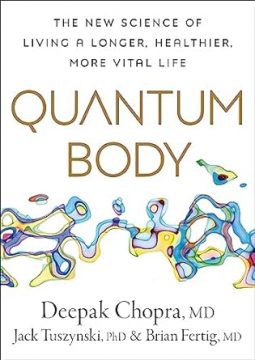
Quantum Body: Quantum Body: The New Science of Living a Longer, Healthier, More Vital Life
Quantum biology and quantum metabolism have a natural intersection with the mind, body, and spirits of the spiritual domain. This led us to connect with Deepak and ultimately the writing of Quantum Body. I don’t have to tell you, John, that Deepak is a great man on many levels. First, I want to say that it’s such a proud feeling and privilege to share the front cover of this book with these two giants of great men.
In terms of whether this is ready for prime-time quantum biology in terms of medicine, when we were all growing up and going to school, the most fundamental tier of medicine or the life sciences was biochemistry. In the late 1990s, it became molecular neurobiology. Now, it’s quantum biology with an interest and a justification for the application of quantum biology to clinical medicine.
Microtubules, based on the Penrose-Hameroff model of consciousness, appear to be vital in the storage and processing of consciousness from which emotional and national intelligence have emerged. While disturbances of these microtubules appear critical for the pathogenesis of chronic disease, these were examples of the emerging role of quantum biology in medicine. These are beautiful examples of this, not to mention the effect or the significance on mind, body, and mental focus, and the effects that this will have on health and healthcare. That’s another major obvious application, which we’re already using and Deepak uses quite a bit with meditation, yoga, and the like. These are going to play an important role.
Think about the definition of consciousness from Sir Roger Penrose. He defines it as an awareness of awareness and awareness of perspectives. This is necessary for understanding to be able to connect the dots of these different perspectives for creative insights. This, in turn, is necessary for natural intelligence, which is the real-world application of problem-solving.
Let me finish up with the application of this from a healthcare perspective. The emotional intelligence that healthcare practitioners must have involves an awareness of the perspectives. They’re robust, well-rounded perspectives of a medical topic as well as of the patient and their fears, expectations, biases, or belief systems. To be able to harness this in the uniqueness of the individual patient for the optimal problem-solving for that individual.
If you have, for example, an obese patient, you’re going to have a prescription that’s going to be unique to the individual for various lifestyle changes with or without prescription agents, pharmacological agents, and which ones, and then with or without a bariatric surgery and which one. It’s going to be unique in terms of the optimal problem-solving given the patient, the uniqueness of that patient, and the experience that the patient has.
These are all examples of where we’re going with quantum biology and the understanding of where it evolves from. Not to belabor it, but I’ll say it because I’m sure there will be more opportunities to describe this. My major interest is in the intersection of quantum metabolism with physiological perfection and how it connects with consciousness and free will. Free will is the quantum biological expression of consciousness as Deepak has described. That resonated with me. There are many, but I’ll leave it at that and give the others a chance to speak.
John, before you ask your next question, I want to share with you two volumes on quantum metabolism, The Metabolic Landscape of Health and Disease. These are two volumes written by our friend, Brian Fertig. I’m still struggling to understand much of the math and the deeper insights that he offers in these. I’m curious to hear Jack’s favorite interpretation of quantum mechanics.
While you were having this conversation, I went online and asked an AI chatbot about Erwin Schrödinger’s interest in consciousness and Vedanta. Schrödinger’s equation is the basis of quantum mechanics. This is what I found from his book, What is Life? In 1944, Schrödinger wrote, “The Upanishads are the most comprehensive philosophical treatise ever written by man. They’re based on an ancient idea as old as Indian thought itself. The most profound reality is one, and this one is identical to our own self. There is no room for a divided self in the Upanishads. There is no conflict between our true selves and the outer world. There is no dichotomy between mind and matter.”
Schrödinger was particularly interested in the Vedanta concept of Ātman, which is the eternal self or reality. He believed that the Ātman is identical to the wave function in quantum mechanics. To me, that was amazing that Schrödinger was talking about consciousness and wave function as being identical to the one ultimate reality. All our physics is based on Schrödinger’s equations, but if you say this in public amongst scientists, they’ll roll their eyes. They’ll say, “What nonsense.” I’m quoting Schrödinger. I’m curious. What is Jack’s favorite interpretation?
Tweet: Consciousness and wave function are identical to the one ultimate reality.
I want to get back to Jack, but I want to ask you a question, Deepak. I’m going to push back a little bit against one of the big themes of your work for as long as I’ve known you and even before that. It’s taking off from what Brian said. It seems to me possible that you can have quantum medicine that remains entirely materialistic.
There’s an understanding of quantum processes, how they’re involved in metabolism, and how they might be involved in neural activity. You don’t have to have any of the metaphysics about consciousness. You don’t have to have the challenge of materialism that you mount in your own writing, your speeches, and so forth. Do you think that’s possible? Why do you need metaphysics? Why do you need the idea that consciousness is somehow primary for quantum medicine to happen?
On the one hand, I agree with you that you can have a materialistic paradigm for quantum mechanics and be done with it and not invoke anything mental, emotional, or consciousness-linked. Any look at reality that excludes the mind, emotions, or consciousness is not complete. Even if we come up with a unified field theory of gravity, strong and weak interactions, and electromagnetism, that’s the whole spiel, how does that give rise to intention, feeling, emotion, insight, intuition, creativity, higher consciousness, or transcendence?
I’ve always been a student of Vedanta all my life. I’m always looking for ways to say that science without including consciousness is going to be incomplete. After all, even science is an activity in consciousness. Theories are conceived in consciousness. Experiments are designed in consciousness, and observations are made in consciousness. How can you have science without consciousness? That’s my bias.
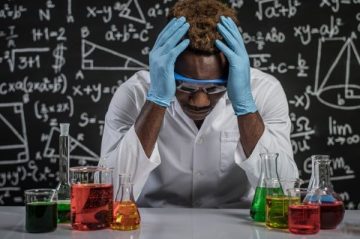
Quantum Body: Science without including consciousness will be incomplete.
One of the implications of what you said is that while we’re waiting for quantum medicine to emerge, there are these practices that we can engage in to improve our health, our mental health, and our physical health.
All these practices include influencing your autonomic nervous system. During the COVID pandemic, it became very clear that people who are having high morbidity or high mortality also had sympathetic overdrive. They had inflammatory storms. Yet, no one was talking about the parasympathetic nervous system, which has been a fascination in the yogic traditions. It’s how breathing, yoga, mindfulness, reflection, and transcendence influence autonomic activity that counters the sympathetic overdrive.
Because of neuroplasticity and epigenetics, we know that every mental event influences biology. You’re talking about quantum metabolism, these huge two volumes. My first insight into this happened as a resident. One day, I was speaking to a patient. I said, “Mr. whatever-his-name-was, I’m afraid you might have cancer.” As soon as I said that, I saw his face was crestfallen. His blood pressure rose. I’m sure his body metabolites showed inflammation in cytokines. His heart rate went up.
In the next minute, I realized that I’d made a mistake. I was reading the wrong chart. I said, “I’m so sorry. That wasn’t your chart. You are perfectly healthy. That is somebody else’s chart.” Immediately, his demeanor and his biology changed. I said to myself, “One little bit of information and its interpretation changed this guy’s biology in a few seconds from one thing to another.”
I didn’t have the expertise that these guys have, but intuitively, I knew that information, or even how you interpret it, you can dismiss it. Placebo and nocebo are words we use when we don’t understand what’s happening. We understand that something very fundamental is happening with information and how we interpret information. Where is this information? It’s in consciousness. Nowhere else.
I can’t help going back to my fascination with what is reality. Why do we exist? We have created all these models for existence, but like you, the more I study these models, the more confused I get. This book is not about any revelation. It’s about enlarging the conversation more than anything else. The conversation needs to be expanded beyond simple materialism, which has failed us, to tell you the truth.

Quantum Body: Quantum Body is not about any revelation. It’s about enlarging the conversation more than anything else.
Thanks. Jack, we’ve set you up for your favorite interpretation of quantum mechanics. At some point, either maybe in your answer, but I can also have a follow-up question, talk about how quantum mechanics relates to information as something that might be fundamental to reality.
Let me preface this by saying that especially regarding biological systems and even the human mind, something is missing in our conversation. People who talk about quantum mechanics and quantum biology always refer to things like single particle experiments. There are very simple and almost rudimentary aspects of quantum mechanics where you have a photon striking an electron, and then the electron changes direction.
In physics, we can follow these kinds of events. In biology, at least for the foreseeable future, this is not achievable. We’re not at this level of resolution, let alone precision. In terms of statistical aspects of quantum mechanics, the consequences for many-particle systems, even a single cell will have trillions of atoms in it. Therefore, if we translate quantum mechanics into such systems, we are risking a very naive approach.
A better approach is to look at consequences in terms of what happens for the entire system, like a cell, maybe a tissue, or an organism if we assume that the underlying physics is based on quantum principles. That frees me from the interpretation because I jump right into quantum statistics. That is what happened with quantum metabolism. It’s based on the thinking that was used in about 1935 or so to explain the specific heats of solids at low temperatures.
For Einstein, there was one of the instances where he was wrong. He assumed that the cell is composed of independent quantum oscillators. That led to an incorrect answer to that question. At least once, he was wrong in his life. Instead, Debye corrected this and said, “These oscillators are connected by little quantum springs. They create waves. When you look at the distribution of these waves or the properties of the quantum waves, then you get the right answer, which is experimentally demonstrated.” It was for some time already.
That’s a better approach to biology from the quantum standpoint. Look for examples of collective behavior that is not explainable by linear billiard ball-type collisions but something collective. That leads us directly to the book where we emphasize the collective behavior of the human body and the systems. They’re not independent. It’s all interconnected. That also links to the mind-body connection that Deepak mentioned as fundamental to our health and even deeper to microbiota body-mind connection of gut-brain access. All these things cannot be mechanistically explained by these domino-like effects. It would be too slow. We are much better organized than that.
To answer your question, because I come from this point of view where quantum statistics or statistical explanations are linked directly to the experiment, I like the Copenhagen interpretation because it’s probabilistic. Probabilities lead to statistics. Everything else from my naive perhaps and maybe not sophisticated enough point of view is a little bit overthinking it.
I remember when I was a student. We were trying to come up with all kinds of ingenious ideas about quantum mechanics. The professor said, “Stop it. Just do it.” In other words, write it down, solve the equation, and then you’ll be happy with that. The Copenhagen interpretation withstood the test of time. I don’t see anything better than that. There are all kinds of exotic things, like the pilot waves or Bohmian. There are multiple multiverses. I’m a nuts and bolts physicist, so I like the simplest possible explanation.
You’re expressing the view that is commonly known as shut up and calculate. I took a course in quantum mechanics a couple of years ago. My professor was too polite to put it that way, but he said, “Do your homework. Figure out how to solve these equations and don’t worry about what all this means.”
What I like about quantum mechanics is how elegant it is mathematically and also how it reflects classical mechanics. In Hamilton’s equations of classical mechanics, you can see the same concepts translated into quantum. To me, that is very convincing because if something is beautiful, it must be true, to me at least.
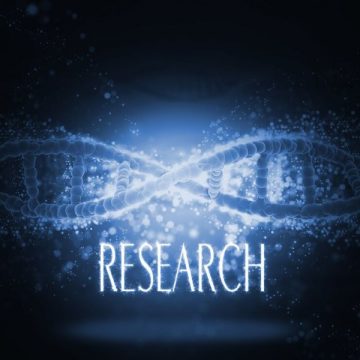
Quantum Body: Quantum mechanics is mathematically elegant.
Thank you. Brian, I’ve been saving a big question for you. Somebody has already mentioned free will. I know free will is important to you. It’s very important to me. I’ve been writing about free will for a long time. There is a lot of discussion of free will because Robert Polsky, the Stanford neurobiologist wrote the book Determined. Meanwhile, there’s another neuroscientist, Kevin Mitchell, who’s written a book that could be called anti Determined. Sapolsky says, “No free will,” and this other guy, Kevin Mitchell, looks at much of the same science and says, “There is free will.” Brian, what’s your take on free will and whether it relates to quantum mechanics?
Thank you, John. Rober Sapolsky, in this book that you’re referring to, says that none of our behaviors, actions, and decisions are voluntary or by choice but rather, they’re predetermined by genetics or biological factors in the environment. He is saying that we have no freewill. I can accept that in some cases of an impaired or deranged consciousness where we could harm ourselves and others, but I reject this notion that all of our actions are inescapably deterministic. It is because consciousness is an awareness of perspectives. A healthy consciousness allows creative insights and, thus, flexibility in what we do. Even my involuntary felt like an involuntary decision to write this medicine in a metabolism tone that spanned a torturous ten years. That was the epitome of free will even though I thought it was involuntary at the time.
Tweet: Consciousness is an awareness of perspectives. A healthy consciousness allows creative insights.
Let me give some perspective on my thinking of free will. What’s most inspiring and important in life is not what you do. It’s why you do it. It’s knowing how our motivations and free will are beneficial to ourselves and others. It’s understanding and believing what is our cause. This is a physiological purpose, which equates to free will or willpower. They’re the same. They’re motivated not only for the acquisition of food for which the brain principally evolved, but for many modern-day vitalizing challenges such as winning a sports competition, an academic accomplishment, or a service to the community.
Free will is the essence of what we are. Many of the challenges of free will are metaphorically tantamount to survival. Fortunately, we’re entangled in a world motivated by a physiological purpose not just to survive as individuals but to help others do so as well and promote the joys, opportunities, health, and general welfare of others which are inextricably entangled with those of our own.
If you reach down and lift others up, you lift yourselves even more. I believe that this is rooted in a biophysical process of quantum entanglement that connects everything in the universe. I know Deepak agrees with this. It’s interesting that Albert Einstein said, “If you do something good, something good comes back to you. It may be in a day. It may be in 100 years.” This could be karma. This could be Newton’s third law. This quantum entanglement is more fundamental than that.
The 2022 Nobel Prize-winning experiment of quantum entanglement was by three physicists, Clauser, Aspect, and Zeilinger. They looked at these electron pairs and separated the pair miles apart with each having a separate spin. They flipped the spin on one and the other instantaneously flipped. If free will is the quantum biological expression of consciousness, then plausibly and arguably, the free will of somebody that you helped many years ago would be responsible for others coming to help you with a major challenge today. You helping somebody now would come back and help you many years from now perhaps in another lifetime. I find that to be fascinating. Free will is something that doesn’t age. It’s the ultimate part of our consciousness that connects physiological perfection.
I want to look at the 2007 New York Giants that beat the 18-0 New England Patriots. They were unbeatable. They tied at 9-17 and beat this team. In that touchdown-winning catch by Plexico Burress from Eli Manning, those 300-pound linemen said, “That ball is in the air so long we thought we could run down and catch the ball.” What that says to me is that the present becomes the past. You’re living in the past. This is a quantum manifestation of consciousness, free will, and metabolism that drives the physiological perfection not only of the individual but also between individuals in this phase-locking phenomenon. That is a beautiful example.
As a Giants fan, I love the connection of quantum mechanics to what is the greatest football game of all time, which is the New York Giants defeating the Tom Brady Patriots.
Thumbs up to that.
If I may, can I add two thoughts to it?
Yeah.
The first one is when I teach biophysics, I always ask students what they think is the difference between living systems and nonliving systems. We talk about biology and physics. Physical systems follow the basics of the forces. The second Newton Law tells us what will happen in the classical sense anyway. Biological systems decide where they want to go, even a single bacterium. You will not be able to guess the movement of the bacterium or pylori. All of life, in my opinion, is based on free will. That’s a distinctive feature of biological systems.
The second comment I want to make is based on what Brian said, and maybe Deepak would be interested in writing another book. A follow-up to this one would be not Quantum Body, but Quantum Society or Quantum Planet maybe. These examples give us this connectivity which, either metaphorically or literally, is a hallmark of quantum behavior.
I wanted to point out that we’re nearing the one-hour mark. I wanted to ask a big question. I wanted to put this to Deepak. This is a very difficult time in human history. People are frightened. A lot of people are in despair. One reason why the free will deniers are so pervasive is because many people feel helpless. Deepak, I wonder if one of the goals of writing your book was to counteract that sense of fatalism and despair by presenting this physics-based way of looking at the human condition that is more hopeful.
The short answer is yes. I came back from the Kingdom of Bhutan where I was invited by the king and the queen. They parceled out a piece of land about the size of the country of Singapore based on the idea of the awakened mind following the principles of compassion, love and kindness, and joyful equanimity. They want to create a whole country around this.
At this moment, the time of despair is that. It is climate change, a non-sustainable biosphere, even our own biology, social-economic injustice, war, terrorism, and mechanized ways of killing each other. It’s happening in Ukraine. It’s happening in the Middle East. When I went to the Kingdom of Bhutan, I saw the celebrative mind there celebrating existence. They were grateful for only one thing. It’s that we exist and that we have the awareness that we exist. For me, that is a worthwhile endeavor to take society in the direction of a more peaceful, just, sustainable, healthier, and joyful world.
Maybe the quantum mechanical model is the right model or maybe it’s not. When I was debating Richard Dawkins in Mexico, I quoted Freeman Dyson. I have his book, Infinite in All Directions. In the book, Freeman Dyson says, “Every quantum experiment forces the atom to make a choice.” That’s the quote I use. It’s a well-known quote from Freeman Dyson. Richard screamed at me. He said, “He couldn’t have said that. If he said it, he was wrong and he should sue you.” I wrote an email to Freeman Dyson and copied Richard on it. I said, “I quoted you. Did I make a mistake?” He said, “You didn’t make a mistake, but there are three riddles.”
Tweet: Every quantum experiment forces the atom to make a choice.
I’d like to end this conversation with these three riddles because we’d run out of time. These are the three riddles that have occupied me all my life. Number one is the unpredictable movement of atoms and particles. He didn’t say random. He said unpredictable. There is a big difference. Unpredictable to me, but maybe not random inherently. It is like going to Grand Central Station and seeing everybody randomly walk here. Every particle or every human is going to a certain destination. Number one is the unpredictable movement of particles and atoms.
Number two is a universe fine-tuned for mind and consciousness. Number three is our own consciousness. I don’t know the answers to these riddles, but I have a feeling they’re connected. If anything, this book can expand the conversation. We are not trying to solve any mystery. It’s not solvable. I don’t think the mystery of our existence or even the awareness of the mystery of our existence is solvable, but any model that expands that conversation to help create a more peaceful, just, sustainable, healthier, and joyful world is worth it.

Quantum Body: The mystery of our existence or even the awareness of the mystery of our existence is not solvable but having a model that expands that conversation to help create a more peaceful, just, sustainable, healthier, and joyful world is worth it.
Thank you so much. That’s a great way to end. Best of luck to all of you with this book. It’s great. I think it’s going to find a big audience, and it should because it’s something that people need out there. Thank you for writing it.
Thank you, John.
Important Links
